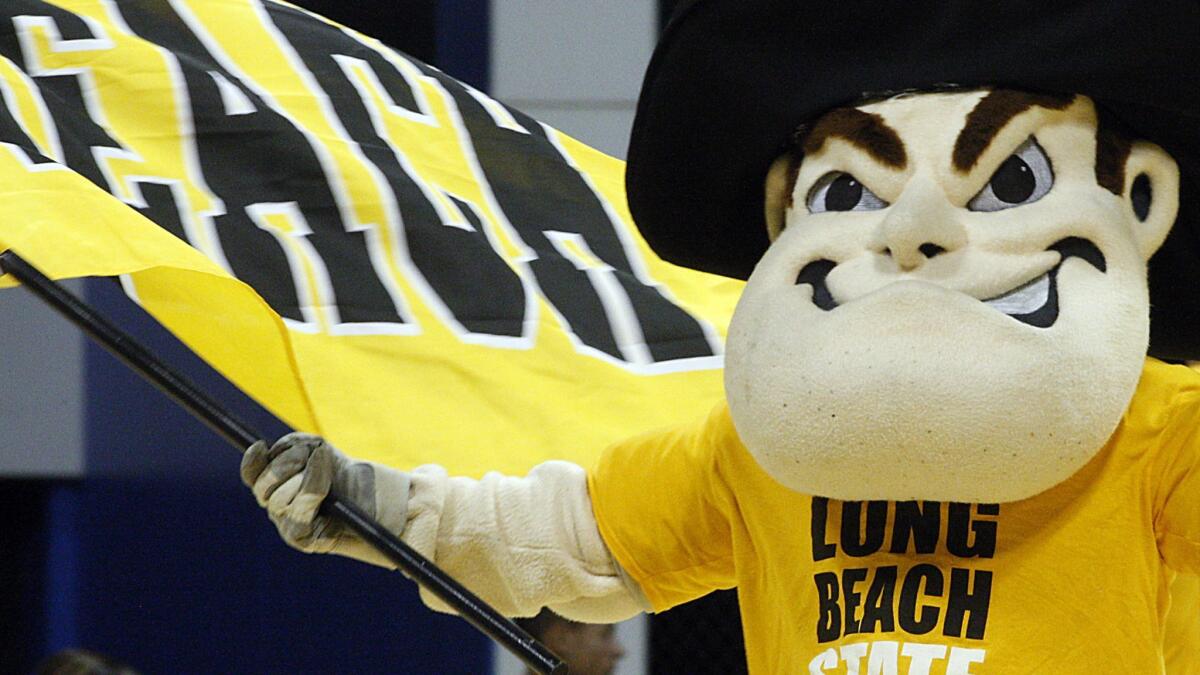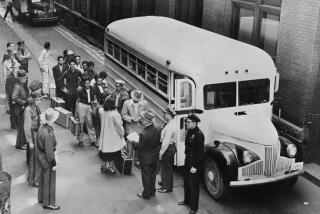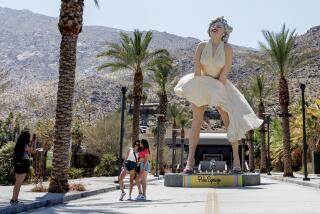Cal State Long Beach retires Prospector Pete mascot amid cries of racism and genocide during California gold rush

- Share via
Cal State Long Beach is sending Prospector Pete packing.
The towering bronze statue that sits in the plaza outside the liberal arts building soon will be relocated to a less prominent place on campus as the university officially moves to retire the mascot that some say represents the state’s history of racism and genocide against Native Americans.
The university’s announcement Thursday comes on the heels of a decades-long debate over the suitability of the “49ers” image, which pays homage to the state’s gold rush, on a college campus that has increasingly welcomed a more culturally diverse student population in recent years.
“As our diversity grew and more voices were heard, we came to know that the 1849 California gold rush was a time in history when the indigenous peoples of California endured subjugation, violence and threats of genocide,” President Jane Close Conoley said in a statement. “Today, the spirit of inclusivity is reflected in our students, faculty, staff, alumni and community. Today’s Beach is not connected to that era.”
The Prospector Pete statue, formally named “The Forty-Niner Man,” evolved from the creation of the campus in 1949 and founding President Pete Peterson’s reference to having “struck the gold of education” by establishing the college. However, students see it largely as a commemoration of prospectors and their participation in an uglier side of the state’s history.
Tension over the mascot began in earnest on the campus following the Vietnam War in the 1970s and has continued to simmer over the years. Scrutiny of the statue reached new heights in light of a nationwide movement to remove public monuments that celebrate controversial historical figures or time periods.
The debate has touched college campuses across the country. Stanford University this month decided to rename three campus references to Father Junipero Serra, who founded the California mission system in the 1700s. His legacy came under fire for the state mission’s treatment of Native Americans. The University of Texas was sued last year by the Sons of Confederate Veterans after officials took down four Confederate statues from a main area on the campus in Austin.
Cal State Long Beach athletics made a subtle shift away from the image in 2014 in favor of the nickname “Beach Athletics.” However, campus student government pushed for a more substantial change in March, when it passed a resolution to retire Prospector Pete and disassociate the college completely from the state’s gold rush era.
The resolution notes that more than 80% of the indigenous American population died in the 20 years following the gold rush from malnutrition, disease, enslavement and massacres.
The campus, and Long Beach as a whole, has deep roots to Native American tradition. Cal State Long Beach is built atop what once was the village of Puvungna, a sacred site to the Gabrielino-Tongva Tribe, where their lawgiver and god — Chungichnish — instructed his people. More than a dozen archaeological sites on or near the campus have been identified as Puvungna village sites, according to the university.
“Multiple scholars have cited the California Prospectors, also known as the 49ers, as culpable in violent and genocidal acts against the indigenous people of California,” the resolution states. “Prospectors in California perpetuated colonization, white supremacy, racism and exclusion ideals not only against indigenous American communities, but also women, people of color and non-Protestant communities.”
Conoley said in an effort to preserve history, the Prospector Pete statue will not be destroyed but will be moved to a new alumni center that is expected to break ground next year.
Whether the university will select a new mascot hasn’t been decided, but officials said they will seek input from students, alumni and the community during a campus vision planning event, called Imagine Beach 2030, in November. Students and some faculty have suggested the university avoid modeling a new mascot after a specific person or group to prevent appropriating a culture or offending others on campus in the future.
Debate over the mascot has become heated on social media, with some alumni and community members alleging the decision sanitizes the state’s history and is the result of a wave of political correctness that has washed over modern society.
Professor Craig Stone, the director of the American Indian Studies Program at the college, supports the mascot change and said the issue centers on the college’s desire to be inclusive. Mascots represent a sense of belonging for students and alumni, and representations that bring up “historical trauma” can alienate people, he said.
“If you want real change, you have to embrace perseverance,” he said. “It’s been an issue for the last 50 years, and now we’re in a moment in time when the culture is receptive to making a change.”
Twitter: @Hannahnfry
More to Read
Sign up for Essential California
The most important California stories and recommendations in your inbox every morning.
You may occasionally receive promotional content from the Los Angeles Times.














